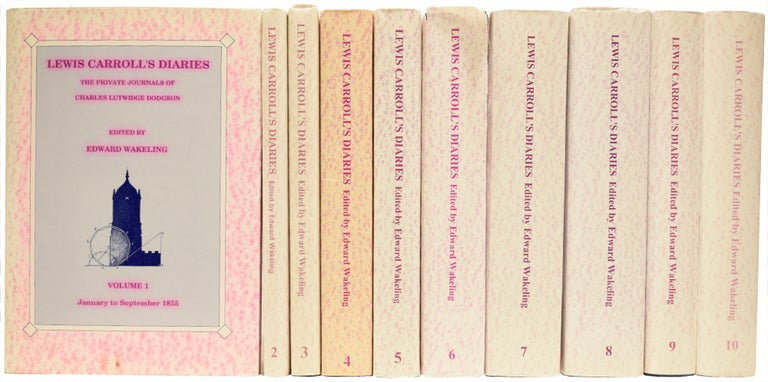(A rare complete set of the undedited diaries, photo by Harrington Books UK)
A dear friend of mine is currently undertaking work in regards to Charles Dodgson/Lewis Carroll's unedited diaries. These are the ones that are most complete and were published in the mid 1990s by the Lewis Carroll Society UK, and edited with expert footnotes by Mr Edward Wakeling. I have now had the jaw dropping oppertunity to read 4 of these. I'll explain why I called this jaw dropping later in this piece, but for now, it is worth reflecting on Mr Wakeling's sheer skill at putting together these diaries as an actual series of books, and piecing together insights that were completely lost/not known in Green's 1950s version.
Its impossible to talk about these diaries without talking about what got lost via other people's editing. Green's edited diaries of an early era, are of course, only half the story. Green omitted, according to Karoline Leach, 50 percent of the diaries. He was handed an edited manscript, edited for content. As documented by Hagues Laibally, Dodgson's own descendants would cut out anything they deemed too "adult" in nature for this children's author to be doing.
What they found much more difficult to cope with was the plentiful evidence [....] of C. L. Dodgson's attendance at and enjoyment of what they considered as coarse performances starring young pert actresses, as well as of the favourable impression various adult female nudes produced on him: proof of such vulgar tastes looked to them far more scandalous, and they suppressed it in a much more consistent and systematic way, unaware that they were thus reinforcing and confirming the already too widespread view of 'Lewis Carroll' as a monomaniac perverse.
So that's any references to romance with adult ladies, and any references to "erotic" art that Dodgson seems to have enjoyed. Laibally also notes that what was omitted was:
13 % of the books C. L. Dodgson read [32 out of 242]
20 % of the plays he witnessed [139 out of 683]
65 % of the concerts he heard [79 out of 121]
53 % of the light entertainments he attended [18 out of 34]
40 % of the exhibitions he visited [87 out of 215]
and 15 % of the individual sculptures and paintings he singled out [44 out of 293]
were omitted from the first printed version of his diary, together with 199 mentions of or
judgments passed on the impersonations of actors and actresses of all ages out of 870 [about 23%]
In Wakeling's restored 1993 diaries, we see:
- Dodgson's art and culture reviews (doesn't like wuthering heights, does like the opera Norma)
- Day to day life details at Christ Church
- Dodgson's growing interest in photography and writing.
- Dodgson's friends, many of whom are adults and often are left out of his story in popular culture.
- Dodgson's attitudes to religion. Volume 4 includes multiple prayers that have long mystified scholars. Why do these prayers appear sporadically across this volume? No one really knows. Leach and Woolf point at a potential love affairs, each with varying theories. Others have rather disingeniously, tried to claim the prayers are about Alice Liddell, who features far less in these diaries than you'd imagine.
Wakeling's 1993 diaries restore a lot of what Green left out, or rather everything in 1993 that existed (minus the cut pages in diary document, which had not been found yet) Taking into context that 1990s era, its a remarkable achievement. Made even more impressive when, upon searching newspaper archives, I found almost nothing but wall to wall myth boosting about Lewis Carroll/Charles Dodgson in newspapers in the 1990s. The climate Mr Wakeling was working in appears to have been one that was media wise openly hostile to carrollians and had long sided with the now known-as-incorrect freudian stance.
This may or may not explain why, inexplicably in my opinion, the press and popular culture as a whole did not react to the findings in the undedited diaries in 1993 or indeed, when the project finished. The supposed, even wanted, "confession" about Alice Liddell never appeared, because it never existed. That doesn't mean at all that these diaries were not "valuable", quite the opposite! Why no one did a piece on these in a public paper is beyond me.
Unfortunately, the only negative thing I can say regarding these diaries is that they are hard to get hold of. This is why I said that my reading of them felt jawdropping to me. They are sold exclusively via the Lewis Carroll Society UK, and exist in full in US university libaries across America. The lack of access is a punishing blow for such important evergreen evidence. I wish I could encourage everyone who's interested in Carroll or has read his works to read these diaries too. And I wish the media could have read them.
SOURCES:
BOOKS:
Leach, Karoline. In the Shadow of the Dreamchild: the myth and Reality of Lewis Carroll, Peter Owen Press, 2015.
Wakeling, Edward, Lewis Carroll's Diaries. The Private Journals of Charles Lutwidge Dodgson, Luton: Lewis Carroll Society, 1993-2007.
PAPERS
Through A Distorting Looking-Glass: Charles Lutwidge Dodgson's artistic interests as mirrored in his nieces' edited version of his diaries. By Hugues Lebailly.
